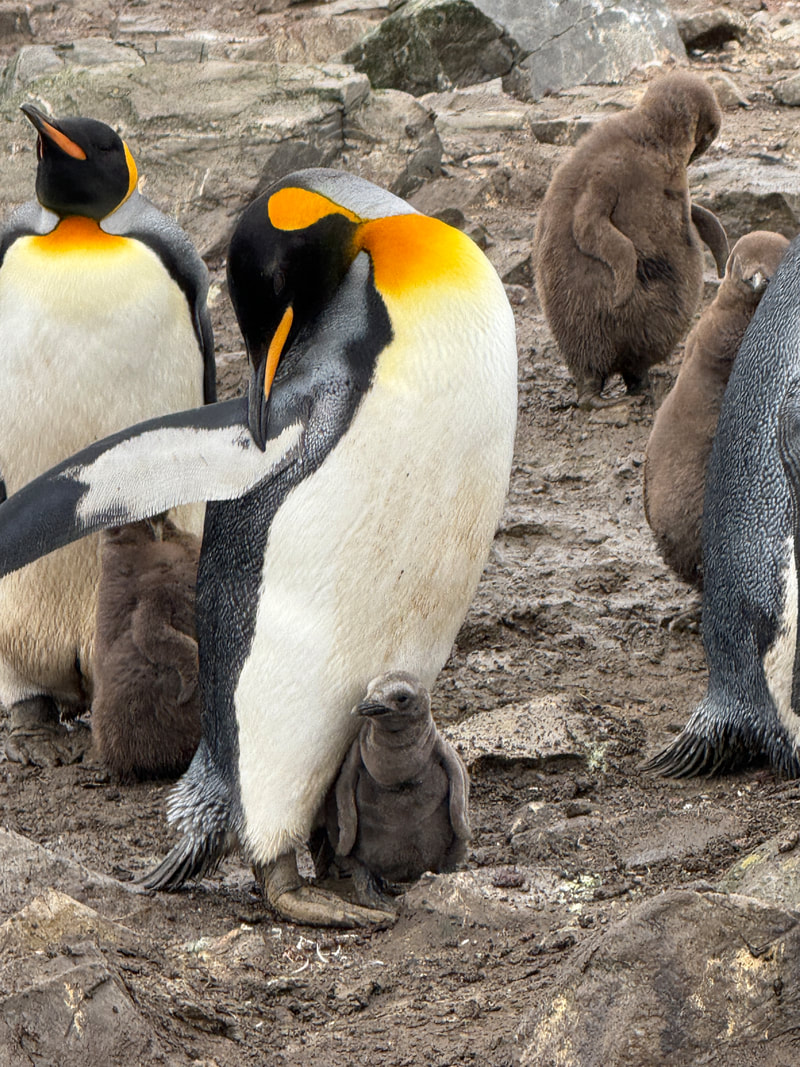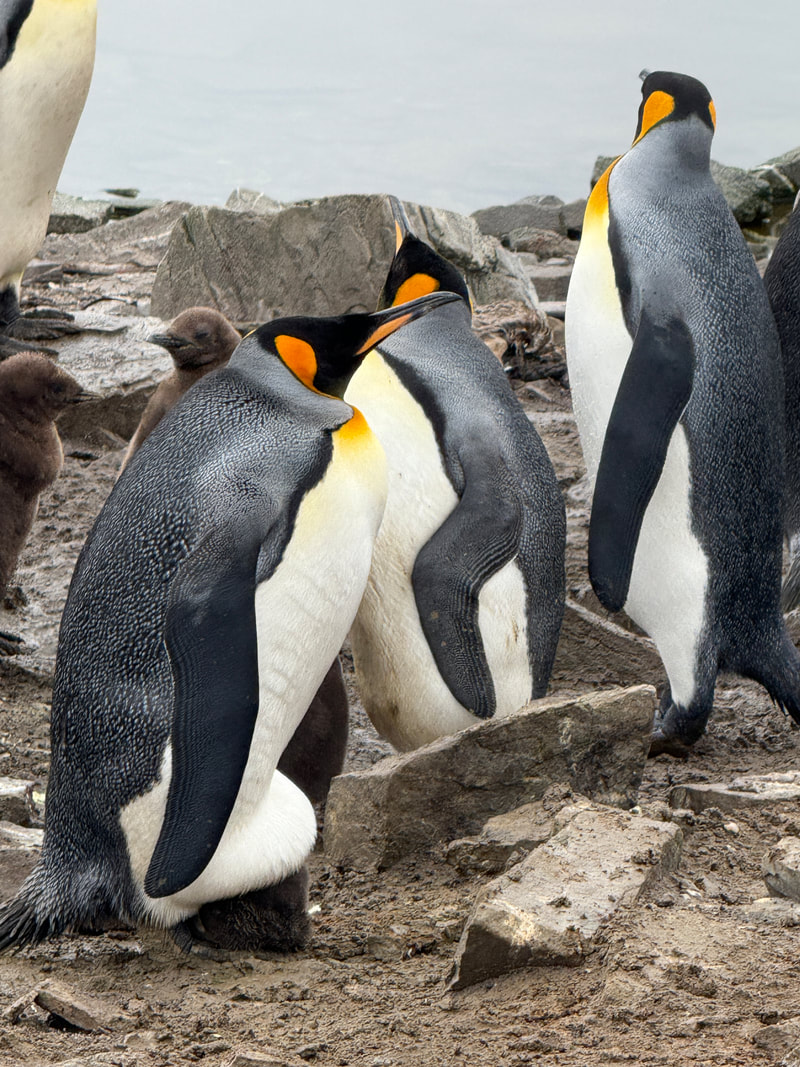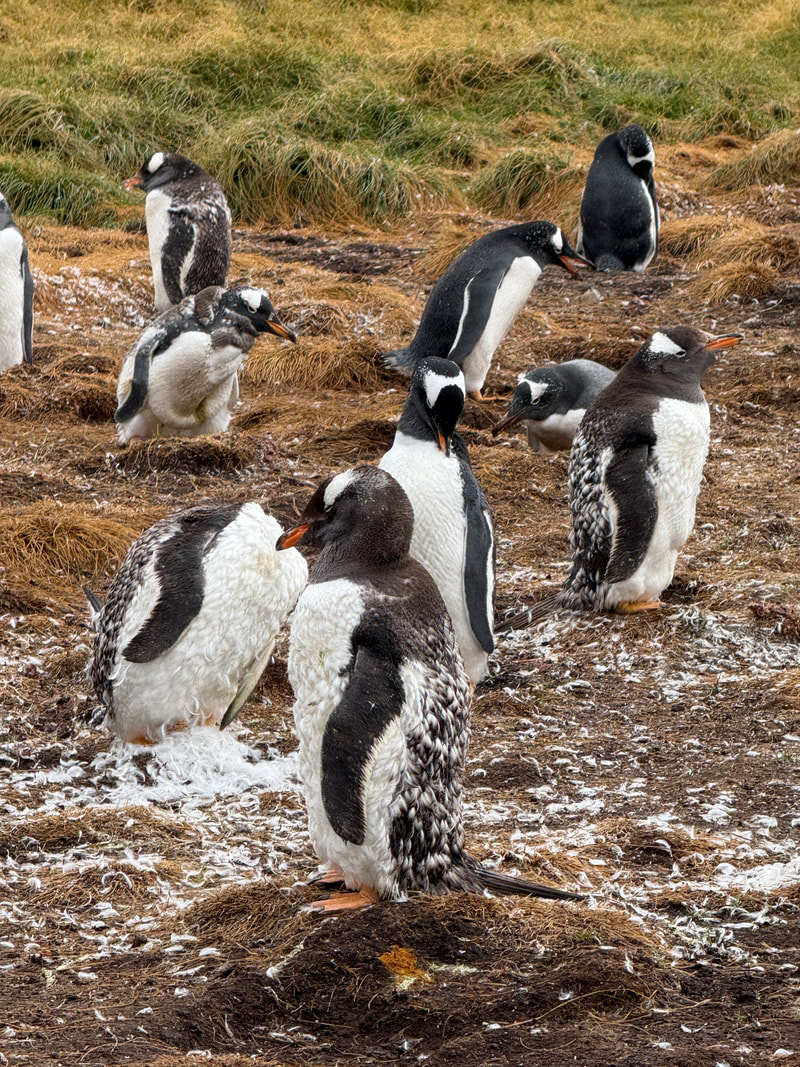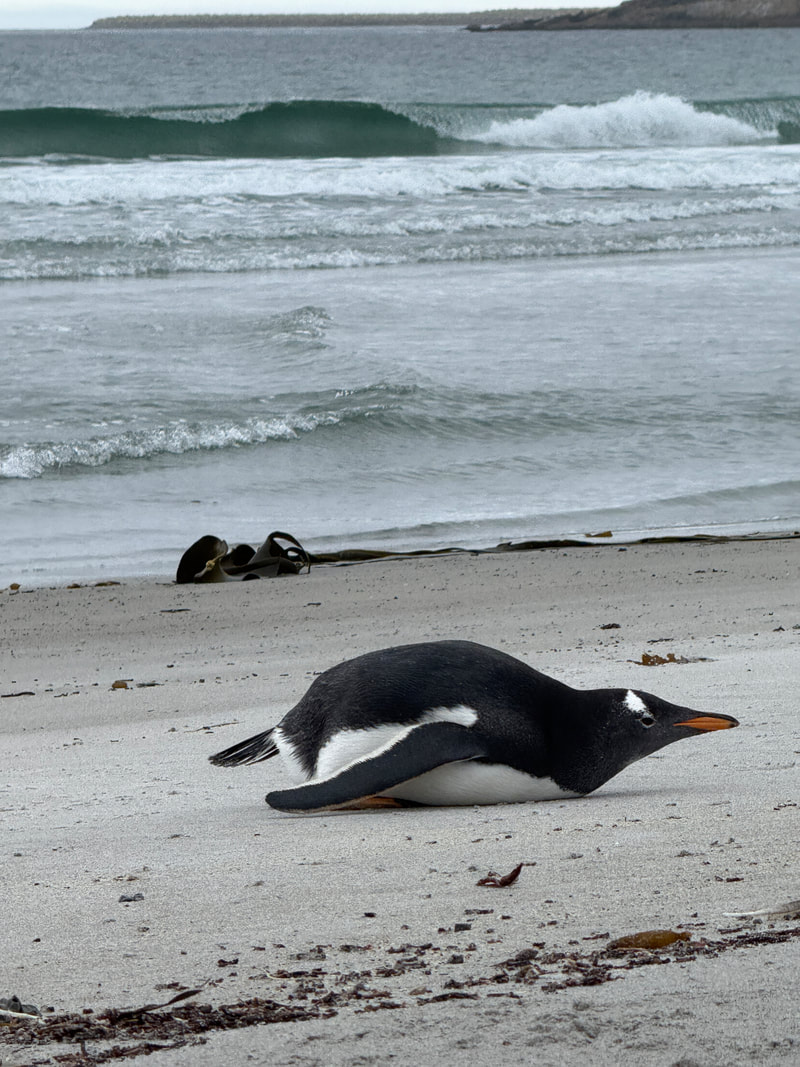Falkland Islands "where the penguins harbor THE SHORE"
Falkland Islands- King Penguins-Bluff Cove Lagoon
While we were impatiently waiting to see the King Penguins close by, we first heard their voices! The choppy noise of king penguin’s chicks calling, adults fighting or wooing made us feel like, we fell into a school yard chaos.
Then after a terrible smell hit our nose! The smell of penguins' dropping like a mixture of fish and ammonia, felt like going to destroy our sense of smell. But these sudden attacks on ear and nose were only a sign of one of the most interesting bird species on the earth were waiting us to see!
Once we were given heads up information how to approach to them, I found myself staring a valley full of king penguins and gentoos. I thought this moment could never come since this was a second try to land on Falkland Island within two years.
The Islands are an Archipelago about 300-mile East of South America in the South Atlantic Ocean on the Patagonian Shelf. Since we were sailing to the Falkland Islands from Antarctic peninsula it was very likely the weather could have change around Bransfield strait because of cold Antarctic water meet with warm water from North, and this could cause a sudden shift in the weather pattern. When we came first time ocean was very active swell was very high and Captain had to cancel Falkland Island. This time even though our day started wet and misty sea was quite calm around Falkland Islands.
East Falkland is in the shadow of the Wickham Mountains faces to the North and wettest part of the Falkland Islands Temperature is 10C (42F) around the year. Bluff Cove Lagoon is a very peaceful wildlife habitat along the white sandy beach on the East Falkland Island. From Port to the Bluff Cove, we had a ride about 45 minutes on the newly made road along the land that was a battlefield in 1982.
Bluff Cove Lagoon is a natural habitat of King Penguins and Gentoos especially during the breeding season. They pick Bluff Cove Lagoon to nest primarily because locations provide a suitable environment for their breeding cycle which is around 15 months from egg laying to chicks leaving home, the place is away from human disturbances and penguins have access to ocean for food. However, we were told that almost all penguin species are very vulnerable to habitat destructions from overfishing to the ecological disasters.
When we arrived at the farm, we were greeted by the rangers, who answered our questions upfront. We had two hours to enjoy these beautiful birds though we were not let to get too close to the Penguins.
A group of Magellan Penguins and were cutely molting on the green field, while Gentoos those known for their orange beak, orange feet, white eye patches walking on the beach sweeping their cute tails from left to the right on the sand. They are quite fast swimmers; they lay 2 eggs at a time and male and female take turn to protect the eggs during 40 days before hatching. They all were extremely domesticated which if you sit still quietly, they come up close and give you the most magical experience of your life.
Suddenly I realized that I felt very happy and free spirited while seeing chasing these fascinating birds and taking the best photo to stop the moment before it was lost. To watch the way, they were running to the water, surfing on the waves and returning from the water by shaking their body from head to tail to get the water off their silky feather was incredibly joyful experience.
The king penguins really did look like that they were the kings of the lagoon. Although they were few in number, their confident appearance, their size and loudness were signs that they were the rulers of the place. Only female king was building the nest male stands to incubate the eggs on top of their feet under their feathery tummy skin. This loose fold of abdominal skin called a brood patch. He takes turn with female to incubate the eggs. Chicks comes naked when they hatch and grown into grayish brown and very soft feather during the grow up. Young chicks mature in about 6 years and feather completely change, Chicks usually dependent to their parents until they grow into waterproof feathers. (13 months).
It was almost the end of breeding season and while some King penguin juveniles were trying to roam around as if declaring their freedom some other chicks were still enjoying the pleasure of hiding under their mothers' foot feathers and being fed by their mothers.
King penguins are the second largest penguin species in penguin family. They are about 85-95 cm tall and weigh 12 Kg, sometime more. They have a long slender bill with a pinkish red to orange yellow stripe on the lower mandible. Their back coat varies gray to black, and they have a white belly. They are perfect divers, sometime 1000 feet for food and can stay 23 minutes under the water. Their natural habitat is Antarctica mostly a Georgia Island and they live in colonies. They prefer to live close to sea at the level ground of gentle slopes.
They were walking slowly like so proud of themselves and I must say that it was very much fun to watch them walking! We didn’t realize how two hours passed so fast, among these fascinating birds while listening their squawking vocalizations by hitting their beaks to each other while stretching their wings into the air like the best musical show on the earth. It was also amazing how male king were protecting his chicks while female fixing the nest carrying a stone one by one.
The owners of the farm had a small coffee shop named “Sea Cabbage” after one of the most common faunas around the area, and a museum as well as a small gift store made up from the cargo containers, which was so comforting to warm up with a peat stove while having a coffee and freshly baked pastries after very windy and cold cove.
We left mesmerizing Sea Cabbage beach’s spectacular vistas of waves crashing on the white sands while chasing penguins with a hope a return!
Who knows!
March 7 2025
While we were impatiently waiting to see the King Penguins close by, we first heard their voices! The choppy noise of king penguin’s chicks calling, adults fighting or wooing made us feel like, we fell into a school yard chaos.
Then after a terrible smell hit our nose! The smell of penguins' dropping like a mixture of fish and ammonia, felt like going to destroy our sense of smell. But these sudden attacks on ear and nose were only a sign of one of the most interesting bird species on the earth were waiting us to see!
Once we were given heads up information how to approach to them, I found myself staring a valley full of king penguins and gentoos. I thought this moment could never come since this was a second try to land on Falkland Island within two years.
The Islands are an Archipelago about 300-mile East of South America in the South Atlantic Ocean on the Patagonian Shelf. Since we were sailing to the Falkland Islands from Antarctic peninsula it was very likely the weather could have change around Bransfield strait because of cold Antarctic water meet with warm water from North, and this could cause a sudden shift in the weather pattern. When we came first time ocean was very active swell was very high and Captain had to cancel Falkland Island. This time even though our day started wet and misty sea was quite calm around Falkland Islands.
East Falkland is in the shadow of the Wickham Mountains faces to the North and wettest part of the Falkland Islands Temperature is 10C (42F) around the year. Bluff Cove Lagoon is a very peaceful wildlife habitat along the white sandy beach on the East Falkland Island. From Port to the Bluff Cove, we had a ride about 45 minutes on the newly made road along the land that was a battlefield in 1982.
Bluff Cove Lagoon is a natural habitat of King Penguins and Gentoos especially during the breeding season. They pick Bluff Cove Lagoon to nest primarily because locations provide a suitable environment for their breeding cycle which is around 15 months from egg laying to chicks leaving home, the place is away from human disturbances and penguins have access to ocean for food. However, we were told that almost all penguin species are very vulnerable to habitat destructions from overfishing to the ecological disasters.
When we arrived at the farm, we were greeted by the rangers, who answered our questions upfront. We had two hours to enjoy these beautiful birds though we were not let to get too close to the Penguins.
A group of Magellan Penguins and were cutely molting on the green field, while Gentoos those known for their orange beak, orange feet, white eye patches walking on the beach sweeping their cute tails from left to the right on the sand. They are quite fast swimmers; they lay 2 eggs at a time and male and female take turn to protect the eggs during 40 days before hatching. They all were extremely domesticated which if you sit still quietly, they come up close and give you the most magical experience of your life.
Suddenly I realized that I felt very happy and free spirited while seeing chasing these fascinating birds and taking the best photo to stop the moment before it was lost. To watch the way, they were running to the water, surfing on the waves and returning from the water by shaking their body from head to tail to get the water off their silky feather was incredibly joyful experience.
The king penguins really did look like that they were the kings of the lagoon. Although they were few in number, their confident appearance, their size and loudness were signs that they were the rulers of the place. Only female king was building the nest male stands to incubate the eggs on top of their feet under their feathery tummy skin. This loose fold of abdominal skin called a brood patch. He takes turn with female to incubate the eggs. Chicks comes naked when they hatch and grown into grayish brown and very soft feather during the grow up. Young chicks mature in about 6 years and feather completely change, Chicks usually dependent to their parents until they grow into waterproof feathers. (13 months).
It was almost the end of breeding season and while some King penguin juveniles were trying to roam around as if declaring their freedom some other chicks were still enjoying the pleasure of hiding under their mothers' foot feathers and being fed by their mothers.
King penguins are the second largest penguin species in penguin family. They are about 85-95 cm tall and weigh 12 Kg, sometime more. They have a long slender bill with a pinkish red to orange yellow stripe on the lower mandible. Their back coat varies gray to black, and they have a white belly. They are perfect divers, sometime 1000 feet for food and can stay 23 minutes under the water. Their natural habitat is Antarctica mostly a Georgia Island and they live in colonies. They prefer to live close to sea at the level ground of gentle slopes.
They were walking slowly like so proud of themselves and I must say that it was very much fun to watch them walking! We didn’t realize how two hours passed so fast, among these fascinating birds while listening their squawking vocalizations by hitting their beaks to each other while stretching their wings into the air like the best musical show on the earth. It was also amazing how male king were protecting his chicks while female fixing the nest carrying a stone one by one.
The owners of the farm had a small coffee shop named “Sea Cabbage” after one of the most common faunas around the area, and a museum as well as a small gift store made up from the cargo containers, which was so comforting to warm up with a peat stove while having a coffee and freshly baked pastries after very windy and cold cove.
We left mesmerizing Sea Cabbage beach’s spectacular vistas of waves crashing on the white sands while chasing penguins with a hope a return!
Who knows!
March 7 2025




